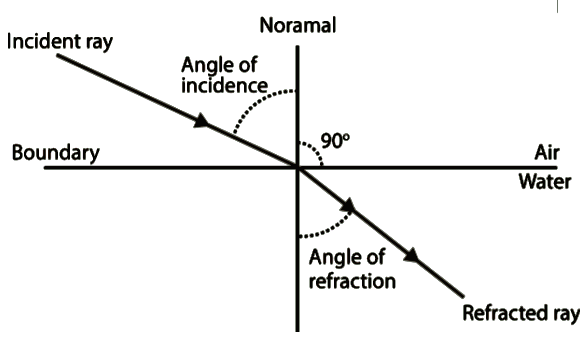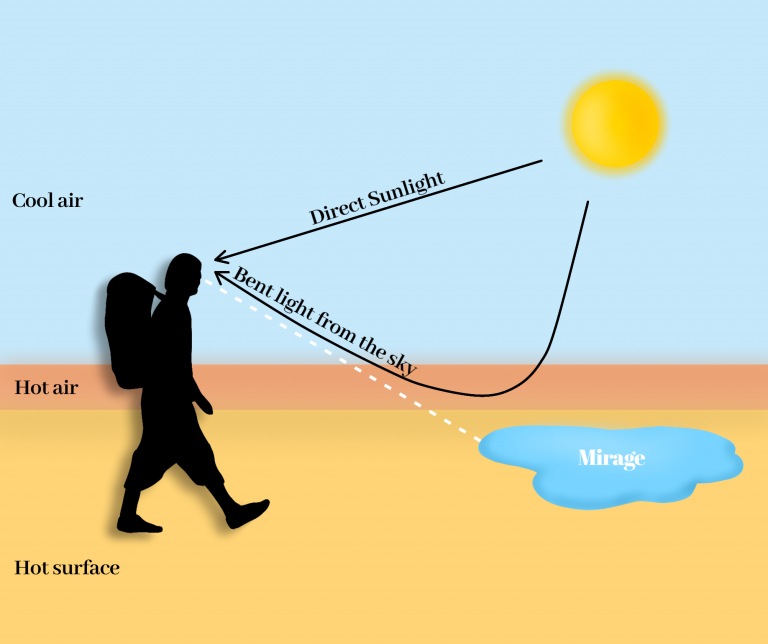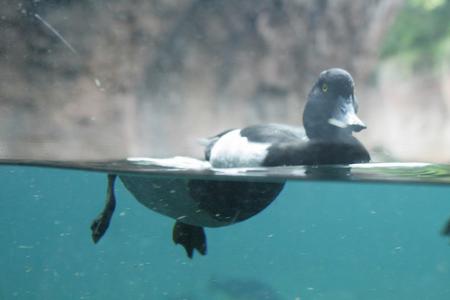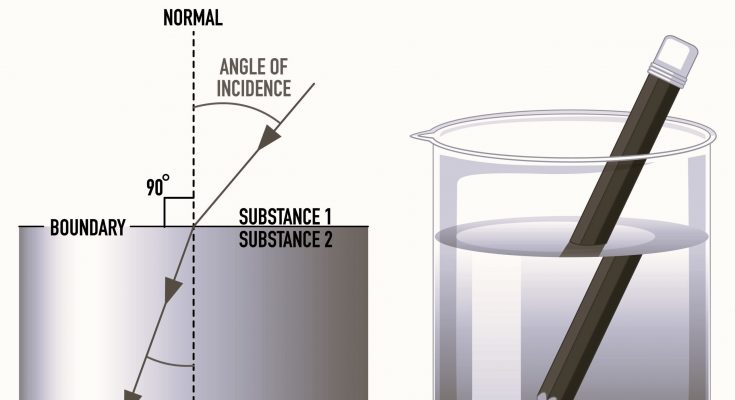Refraction is a fundamental concept in physics, particularly in the study of light and optics. At its core, refraction is the bending of light as it passes from one medium into another. This phenomenon occurs due to a change in the speed of light when it moves between different mediums – for instance, from air into water or from water into glass.
Why does this happen? Light travels at different speeds in different materials. When light moves from a medium where it can travel faster (like air) into a medium where its speed is slower (like water), the light ray bends at the boundary between these two substances. This bending effect is what we call refraction.
The importance of refraction extends far beyond the classroom. It plays a crucial role in our daily lives and has numerous practical applications. For instance, refraction is the principle behind the working of lenses in glasses and cameras, allowing us to correct vision and capture images. It’s also the magic behind rainbows in the sky and the reason why a straw looks bent when placed in a glass of water. In scientific research and technological applications, understanding refraction helps in designing and using optical instruments like microscopes and telescopes.
Table of Contents
Why Refraction Occurs- The Causes of Light Bending
Refraction occurs due to the change in speed of light when it passes through mediums of different densities
Refraction, the bending of light as it passes from one medium to another, is a phenomenon that intrigues many. To understand why refraction occurs, it’s crucial to delve into the fundamental causes behind this fascinating optical event.
Speed Variation and Density Differences
The speed of light changes depending on the medium it travels through. In less dense mediums like air, light travels faster, but as it enters denser mediums such as water or glass, its speed decreases. This variation in speed is a primary cause of refraction. For instance, when light rays move from air (less dense) into water (denser), they slow down, resulting in the bending of the light path.
The concept of density is integral to understanding refraction. The density of a medium refers to how tightly its particles are packed. Denser mediums, with more closely packed particles, slow down light more than less dense mediums. This difference in particle arrangement affects the light’s path, causing it to bend. This is why, for example, a pencil appears bent when partially submerged in water; the light from the pencil refracts as it moves from water to air.
The Principle of Least Time and Optical Density
Another key principle in understanding why refraction occurs is the principle of least time. Light always takes the path that requires the least time to travel from one point to another. When light travels from a medium like air to a denser medium like water or glass, it changes direction to adhere to this principle, leading to refraction.
Furthermore, the concept of optical density plays a significant role. Optical density, different from physical density, relates to how much a medium slows down light. A medium with a higher optical density will slow down light more significantly, leading to greater bending of the light rays. The difference in optical densities between two mediums determines the extent of light bending. For example, light bends more significantly when moving from air to diamond (which has a higher optical density) than from air to water.
The causes of refraction are rooted in the variations in light speed due to density differences and the principles of least time and optical density. These principles not only explain why refraction occurs but also provide insight into the behaviour of light in different environments and materials.
Also Check – What is Light Reflection? A Simple Guide to Understanding Reflections
Laws of Refraction of Light
To comprehend how light behaves when it refracts, it is essential to understand the two fundamental laws of refraction. These laws, grounded in physics, provide a framework for predicting and explaining the behaviour of light as it moves between different mediums.
First Law of Refraction
The first law of refraction states that the incident ray, the refracted ray, and the normal to the interface of two media at the point of incidence all lie in the same plane. In simpler terms, when a ray of light hits the surface of a medium (like water or glass), the path of the light before and after it enters the medium, along with an imaginary line perpendicular to the surface (the normal), all lie in a single flat plane. This law helps us understand the direction in which light will bend.
Second Law of Refraction (Snell’s Law)
The second law, more commonly known as Snell’s Law, quantifies the bending of light. It states that the ratio of the sine of the angle of incidence (the angle between the incident ray and the normal) to the sine of the angle of refraction (the angle between the refracted ray and the normal) is a constant. This constant is known as the refractive index. Mathematically, Snell’s Law is expressed as-
n1 * sin(θ1) = n2 * sin(θ2)
In this equation-
- n1 and n2 are the refractive indices of the first and second media, respectively.
- θ1 is the angle of incidence, which is the angle between the incident ray and the normal.
- θ2 is the angle of refraction, which is the angle between the refracted ray and the normal.
Illustrating the Laws of Refraction
To visualise these laws, imagine a light ray passing from air into water. When the light hits the water surface, the first law tells us that the paths of the incident and refracted rays, along with the normal at the point of incidence, will all lie in the same plane. Snell’s Law then allows us to calculate the exact path the refracted ray will take in the water based on the angle at which the light entered and the refractive indices of air and water.

Also Check – Laws of Refraction- A High School Student’s Comprehensive Guide
What is Refractive Index
A key concept in understanding refraction is the refractive index, a value that indicates how much a material can bend light. The refractive index is a ratio that compares the speed of light in a vacuum to its speed in a specific medium. It gives us a numerical measure of how much a material can slow down and consequently bend the light.

Defining Refractive Index
Refractive index is a measure of how much a substance can bend light. It’s the ratio of the speed of light in a vacuum to its speed in that substance. A higher refractive index means the substance bends light more.
Mathematically, the refractive index (n) is expressed as-
n = (Speed of light in vacuum) / (Speed of light in the medium)
In this equation-
- “n” represents the refractive index.
- The “Speed of light in vacuum” is the constant speed at which light travels in a vacuum.
- The “Speed of light in the medium” is how fast the light travels in the material being considered, like air, water, or glass.
Since the speed of light in a vacuum is the fastest possible, the refractive index of any medium is always greater than 1. A higher refractive index means that the medium can bend the light more significantly.
Importance in Determining Light Bending
The extent to which light bends when entering a different medium depends largely on the refractive index. When light passes from a medium with a lower refractive index to a medium with a higher one, it bends towards the normal. Conversely, if it passes from a medium with a higher refractive index to one with a lower, it bends away from the normal.
Comparing Refractive Indices
To illustrate, let’s compare the refractive indices of some common substances-
- Air has a refractive index of approximately 1.00, very close to a vacuum, so it bends light very little.
- Water has a refractive index of about 1.33, meaning it can bend light more than air.
- Glass varies in its refractive index, but typical glass has a refractive index around 1.5, bending light more than water.
This comparison shows why objects look distorted when observed underwater and why lenses made of glass are effective in bending light to focus images.
Also Check – What is Light? An Easy-to-Understand Guide
Real-Life Examples of Refraction
Refraction is not just a theoretical concept; it manifests in many fascinating phenomena we observe in our daily lives. Understanding these examples helps us connect the theory of refraction with the world around us.
Mirages

A mirage is a classic example of refraction in action. It typically occurs in deserts or on hot roads, creating the illusion of water. This happens when the ground gets extremely hot, warming the air directly above it. As light travels through cooler air into this hot, less dense air, it speeds up and bends away from the normal. This bending of light rays creates the illusion of water, as the light from the sky is refracted to the observer’s eyes.
Rainbows

Rainbows are another beautiful example of refraction. They occur when sunlight passes through raindrops in the atmosphere. Each raindrop acts like a tiny prism. As sunlight enters a raindrop, it is refracted (or bent), then reflected inside the drop, and refracted again as it exits. This double refraction causes the light to spread out and separate into its constituent colours, forming a colourful arc in the sky.
Objects Underwater

Have you ever noticed how objects underwater seem distorted or closer than they really are? This is also due to refraction. When light rays pass from water (a denser medium) to air (a less dense medium), they bend away from the normal. This bending makes the objects appear at a different position or depth than they actually are.
Linking to Refraction
Each of these examples demonstrates the principles of refraction in a tangible way. Whether it’s the bending of light in a mirage, the dispersion of light in a rainbow, or the distortion of images underwater, they all tie back to the fundamental concept of light changing speed and direction as it moves between different mediums.
Applications of Refraction
Refraction is not only a fascinating physical phenomenon but also a crucial principle in many practical applications. Its role in the design and functioning of various optical devices impacts technology, science, and everyday life.
Lenses and Glasses
One of the most common applications of refraction is in lenses, which are the cornerstone of optical instruments like cameras, microscopes, and telescopes. Lenses use the principle of refraction to bend light rays in such a way that they form a clear image. For example, a convex lens can bend light rays to meet at a point (focal point), enabling cameras and telescopes to focus distant objects.
Glasses and contact lenses are personal applications of refraction. They correct vision by adjusting the way light rays bend as they enter the eye, ensuring that the image is focused correctly on the retina. Whether for nearsightedness or farsightedness, these corrective lenses are designed based on the principles of refraction to help people see more clearly.
Optical Instruments
In scientific research and medical diagnosis, instruments like microscopes and endoscopes rely on refraction. These devices use lenses to magnify small or distant objects, allowing for detailed observation and analysis. The precise control of light paths through these lenses is critical to their functionality.
Everyday Life and Technology
Beyond these, refraction is integral to numerous everyday technologies. For instance, fibre optic cables, which are pivotal in telecommunications, use the principle of total internal reflection, a form of refraction, to transmit light signals over long distances with minimal loss.
Emphasising the Practical Importance
Understanding refraction is essential not only for students pursuing science but for anyone interacting with modern technology. It is a fundamental concept that underpins the operation of many devices we use daily, from smartphones with cameras to the glasses many wear to improve vision.
FAQs and Problem Solving
Q- Why does a straw look bent in a glass of water?
Answer- The straw looks bent due to the change in light speed as it moves from water to air. Light bends away from the normal when moving from a denser medium (water) to a less dense medium (air), making the part of the straw in water appear to be at a different position than it actually is.
Q- Can refraction be used to focus light into a point?
Answer- Yes, lenses use refraction to focus light. Convex lenses, in particular, bend light rays inward to a focal point. This property is used in devices like magnifying glasses and cameras.
Q- Why do objects underwater appear closer than they really are?
Answer- When light rays travel from water to air, they bend away from the normal. This bending causes the objects to appear at a shallower depth than they are, making them seem closer to the surface.
Sample Problems
Problem- A light ray enters a glass slab (refractive index = 1.5) from air at an angle of incidence of 30 degrees. Calculate the angle of refraction inside the glass.
Solution- Use Snell’s Law, where n1 * sin(θ1) = n2 * sin(θ2).
Here, n1 = 1 (for air), θ1 = 30 degrees (angle of incidence), and n2 = 1.5 (for glass).
Calculate sin(θ2) = sin(30 degrees) / 1.5. This gives θ2 (angle of refraction) as approximately 19.47 degrees.
Problem- A fish is 4 metres below the surface of the water. To a person looking from above, how deep does the fish appear?
Solution- Use the formula for apparent depth- d’ = d / n.
d is the real depth (4 metres) and n is the refractive index of water (1.33).
Calculate the apparent depth- 4 metres / 1.33, which is approximately 3 metres.
Problem- A person is standing 6 metres away from a mirror. If they move 2 metres closer, how much closer to their image in the mirror do they get?
Solution- When a person moves towards a mirror, their distance to the image decreases by twice the distance they move. So, moving 2 metres closer to the mirror brings them 4 metres closer to their image (2 metres x 2).
Problem- Light enters a diamond (refractive index = 2.42) from air at an angle of incidence of 45 degrees. Find the angle of refraction inside the diamond.
Solution- Apply Snell’s Law- n1 * sin(θ1) = n2 * sin(θ2).
Here, n1 = 1 (air), θ1 = 45 degrees, n2 = 2.42 (diamond).
Calculate sin(θ2) = sin(45 degrees) / 2.42. This gives θ2 as approximately 18.61 degrees.
Problem- An aquarium’s glass wall is 12mm thick with a refractive index of 1.5. A light ray strikes the glass wall at a 60-degree angle to the normal. What is the thickness of the glass as it appears to an observer outside the aquarium?
Solution- Use the formula for apparent thickness- t’ = t / n, where t is the real thickness and n is the refractive index.
t is 12mm, n is 1.5.
Calculate the apparent thickness- 12mm / 1.5, which is 8mm.
Problem- If a light ray travels from water (refractive index = 1.33) to glass (refractive index = 1.5) at an angle of 30 degrees, what is the angle of refraction in the glass?
Solution- Again, use Snell’s Law- n1 * sin(θ1) = n2 * sin(θ2).
Here, n1 = 1.33 (water), θ1 = 30 degrees, n2 = 1.5 (glass).
Calculate sin(θ2) = (sin(30 degrees) * 1.33) / 1.5. This gives θ2 as approximately 26.06 degrees.
Curious Queries- Beyond the Basics of Refraction.
Question- Why doesn’t refraction occur when light passes straight through a glass window without bending?
Answer- Refraction occurs when light enters a medium at an angle, causing it to bend. When light passes straight through a glass window (perpendicular to the surface), it doesn’t change direction, so we don’t observe noticeable refraction. Although the light speed changes when entering and exiting the glass, the direction remains the same because it hits the surface at a 90-degree angle.
Question- Can refraction happen in gases, or is it just in liquids and solids?
Answer- Yes, refraction can and does occur in gases. While the effect is more pronounced in liquids and solids due to their higher densities, gases can also refract light. For example, the shimmering effect seen above a hot road is due to refraction in the layers of air at different temperatures, which have slightly different densities.
Question- If water bends light, why can’t we use a water-filled sphere as a magnifying glass?
Answer- In theory, a sphere of water can act like a lens and magnify objects, just like a solid glass lens. However, in practice, the water’s surface tension and movement make it difficult to form and maintain a perfect spherical shape needed for consistent magnification. Additionally, the optical quality might not be as clear and precise as a solid glass lens.
Question- Can refraction cause objects to appear in places they aren’t actually present?
Answer- Yes, refraction can create optical illusions where objects appear to be in a different location than where they really are. A classic example is a pencil appearing bent when partially submerged in water. The bending of light rays as they move from water to air creates the illusion of the pencil being at a different angle or position.
Question- Is it possible for refraction to colour objects differently?
Answer- While refraction itself doesn’t change the colour of objects, it can separate white light into its component colours (like in a rainbow). This separation, known as dispersion, occurs because different colours bend by different amounts. For instance, a prism can refract sunlight and create a spectrum of colours, but it doesn’t permanently change the colour of the objects it refracts.
Also Check – Concave Lenses- Applications, Image Formation, and Principles
Also Check – Convex Lens Ray Diagrams and Image Formation
Also Check – Convex Lenses- Principles, Applications, and Insights

